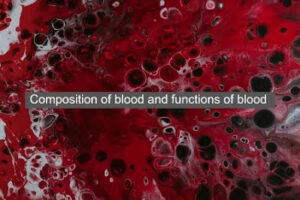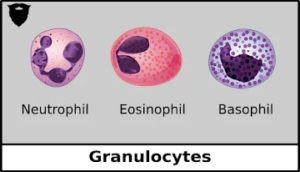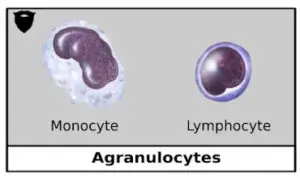We are aware of the fact that blood is the most important part of our life, but what exactly is the definition of blood and what is it exactly composed of ? Since we know a little about blood I’ll be explaining it in brief.
Blood is a body liquid in humans and animals. It is derived from the Latin word “Haema”. It may be in the form of liquid but it is also made up of some solids known as corpuscles. From now in this post we are only going to be discussing about the composition of blood. Apart from that we are also going to be looking at the functions of blood.
Table of Contents
Composition of blood:
Blood is composed of plasma which is the liquid part and corpuscles which is the solid part. We are going to be discussing both plasma and blood corpuscles in detail. Study of blood is called haematology.
Plasma:
Plasma forms 50-60% of your blood and the rest are corpuscles. It is faint yellow or straw coloured, slightly alkaline, viscous fluid. It is extracellular. Plasma composed 90-92% water and 8-10% solutes.
Breaking the composition down. It consist of 90% water, 7% plasma proteins such as serum albumin (regulates osmotic pressure), serum globulin (maintains immunity), prothrombin and fibrinogen (helps in blood clotting), haemaglutin, immunoglobin, etc..
Rest 3% includes glucose, amino acids, cholesterol, mineral salts like bicarbonate, carbonate, chlorides, sulphate and phosphate of Na, K, Ca, Mg, etc., organic compounds, gases in dissolved state like O2, CO2, etc. and wastes like urea, creatine, uric acid, etc..
Blood corpuscles:
Blood corpuscles are solid part of the blood which are suspended in plasma. They are important for proper functioning of the body. Corpuscles make up 45% volume of the blood. They are also known as hematrocrit of the blood.
There the three types of corpuscles – Erythrocytes (They contain haemoglobin and are termed as RBCs), Leucocytes (They do not contain haemoglobin and are termed as WBCs) and Thrombocytes (These are known as platelets and are found only in mammals).
Erythrocrytes or Red Blood Corpuscles:
Erythrocyctes are circular, biconcave, enucleated (only in mammals) cells which gives red colour to the blood. This red colour is caused due to iron present in erythrocytes. Its diameter is 7μm and thickness is 2.5μm. Average life span is of 100-120 days. Each erythrocyte is covered in a plasma membrane which is made up of lecithin and cholesterol.
It is made up of four haem group and one globin molecule. Haemoglobin is found in the cytoplasm of the RBC. Largest RBC is the amphibian RBC among the vertebrates and the smallest RBC is of mammals.
The RBC count in females and males varies. RBC count in females is 4.3 to 5.2 million RBCs/cu mm and the RBC count for males is 5.1 to 5.8 million RBCs/cu mm.
Just like RBC count the haemoglobin content also varies for males and females. Haemoglobin content for an adult male is 13-18 mg/100ml blood and the haemoglobin content for an adult female is 11.5-16.5 mg/100ml blood. Number of RBCs is counted by haemocytometer.
Increase in the RBC count can lead to polycytheamia and decrease in the RCB count results in anemia. Anemia is a condition where the body lacks healthy red blood cells which is essential to carry oxygen to the tissues from the lungs. Anemia can be chronic or acute.
RBCs are formed in the spleen and liver when in foetus form and once when adult its formation occurs in the bone marrow. The process of formation of RBCs is known as erythropoiesis. When in developing stage they are colourless and have a large nuclei. Once, they are ready to be released in the blood stream they loose nuclei and instead contain haemoglibin. Hence, they are referred to as corpuscles and not cells.
Every second 2.5 million RBCs are destroyed in the spleen (main) and also the liver. During the time they are being destroyed they undergo haemolysis which gives haem and globin. Haem forms haemosiderin and the iron in it is sent back into the blood stream and globin gets converted into bile pigments – Bilirubin and Biliverdin.
Functions of RBC:
- Transports oxygen from lungs to tissues.
- Transports carbon dioxide form tissues to lungs.
- Maintains pH of the blood as haemoglobin acts as a buffer, meaning, haemoglobin has a neutralizing effect.
- It maintains the viscosity of the blood.
Leucocytes or White Blood Corpuscles:
Leucocytes have no pigments hence they are colourless, nucleated and phagocytic cells. They have a amoeboid movemet (crawling) which helps them to squeeze out of capillaries easily and reach the infected tissue area. This is called as diapedesis. It has no definite shape.
They are larger in size than RBCs (8 to 15 μm). Total WBC count is 5000 to 9000 WBCs/cu mm blood. Average life span is of 3 to 4 days. They are less in number compared to RBCs (Ratio – 1 WBC to every 600 RBC). There are two types of leucocytes – Granulocytes and Agranulocytes.
Decrease in the number of of WBCs lead to leucopenia and increase in the number of WBCs lead to leucocytosis. In some acute infections, the number of WBCs can increase. Pathological increase in the WBC results in leukemia which is also commonly known as blood cancer.
WBCs are formed in red bone marrow, spleen, lymph nodes, tonsils, thymus and Payer’s patch. The process of formation of WBCs is known as leucopoiesis. The old WBCs are destroyed in the blood, liver and lymph nodes by the process of phagocytosis.
Functions of leucocytes:
- To protect the immune system.
- To fight against diseases.
Granulocytes:
Granulocytes are cells which have granules on their cytoplasm. The contain nucleus which is large and irregular in shape but are lobed. Hence, these are also called as polymorphonuclear cells. They are produced in the red bone marrow by myceloblasts.
Granulocytes fight normal infections like allergy, dust, etc.. There are three types of ganulocytes – Neutrophils, Eosinophils and Basophils.
Neutrophils:
The granules of neautrophils take up neutral dye when staining, hence the name. The constitute 54 to 62% of the total WBCs. The nucleus is multilobed and 3 to 5 in number. Hence, they are called polymorphonuclear leucocytes or polymorphs. The cytoplasm contains five granules.
They are 12 to 15 μm in diameter. They are phagocytic in nature and show amoeboid movement which helps them to move 40 μm/minute. The average life span of neutrophils is 10 to 12 hours. They give protection against infections and form the first line of defence in microbes.
Eosinophils (Acidophils):
The granules of eosinophils take up acidic dye when staining such as of eosin. The granules are large in size and pick up a red colour stain. They constitute 2-3% of total WBC. The average life span of eosinophils is of 14 hours. They are 10 to 15 μm in size. These are non-motile but are slightly or non-phagocytic in nature.
The nucleus is bilobed and picks up a deep purple colour stain. They show anti-histamine property (used to fight against allergies). Increase in the number of eosinophils is called eosinophilia. Allergic disorders can result in the increase in numbers of eosinophils.
Functions of eosinophils:
- Destructs toxins of protein origin which are produced by invading microbes.
- Involved in healing of wounds.
Basophils:
The granules of basophils are stained with basic dye such as methylene blue. They constitute 0.5-1.0% of total WBC. They are 10 to 15 μm in diameter. They are non-phagocytic and their life span is of 8 to 12 hours.
The nucleus is twisted and of 2-3 lobes which takes up a dark purple stain. The granules are few in number. They release heparin (anticoagulant) and histamine. Hence, they are significant in allergic reactions.
Agranulocytes:
Agranulocytes do not show granules on their cytoplasm. Their nucleus is single, simple and not lobed. They fight major diseases. There are two types of agranulocytes – Lymphocytes and Monocytes.
Lymphocytes:
Lymphocytes are small cells with large and round/indented nucleus. They are 8 to 16 μm in size. They constitute 25-33% of the total WBC. They are less motile compared to other leucocytes. The cytoplasm is less compared to the size of the nucleus.
Lymphocytes are produced in lymph nodes, spleen, thymus, etc., derived from lymphoblasts (precursor). They produce antibodies, antitoxins and is also responsible for the immune response of the body. There are two types of lymphocytes – Small lymphocytes and large lymphocytes.
- Small lymphocytes – They are larger in size than RBCs. They are 7 to 10 μm in size. The nucleus is large and stains with basic dyes.
- Large lymphocytes – They are 10 to 14 μm in size. They have large quantity of cytoplasm.
Monocytes:
Monocytes are the largest of all the WBCs. They are 12 to 15 μm in size. They have clear cytoplasm and they are more than nucleus. They are phagocytic in nature which removes invading microbes and cell debris, because of this they are also known as scavengers. They have an average life span of 10 to 12 hours.
The nucleus is large, kidney shaped or oval and not lobed. They are produced in lymph nodes and spleen, derived from monoblasts. They constitute 1-5% of total WBC. They are actively motile.
Platelets or Thrombocytes:
Platelets are non-nucleated, round and biconvex. These are the smallest elements of blood which measure up to 2.5 to 5 μm in size. These are not living cells. They have a total count of 2.5 to 4.5 lakhs/cu mm blood. They have an average life span of 5 to 10 days.
Platelets are formed by fragments of large cells called megakaryocytes of the bone marrow. Formation of platelets is called thrombopoiesis. Increase in the number of platelets is called thrombocytosis and decrease in the number is called thrombocytopenia.
These are used in coagulation/clotting of blood. They form a platelet plug at the site of injury and releases thromoplastin which helps in clotting the blood.
Functions of blood:
Following are the functions of the blood:
- Transports oxygen and carbon dioxide from the lungs to tissues and vice versa.
- Transports food from intestine to the liver first and the to the whole tissues of the body.
- Transports waste products to kidneys, lugs, skin and intestine in order for it to be eliminated.
- Transports hormones to vital tissues which are secreted by the endocrine gland.
- It maintains the pH.
- Balances water.
- Transports heat from deeper tissues of the body to the surface.
- Gives defence against infection.
- It regulates the temperature.
- Arteries help to support the tissues.
- Prevents loss of blood by clotting.
- Heals wounds.





